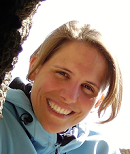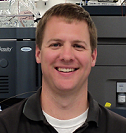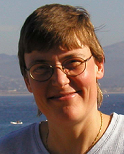Table of Contents |
guest 2025-12-21 |
Speakers
Jeffrey Whiteaker, Ph.D.
Andrew B. Stergachis
Christina Ludwig, Ph.D.
Susan E. Abbatiello, Ph.D.
J. Will Thompson, Ph.D.
Birgit Schilling, Ph.D.
Jarrett D. Egertson
Brendan MacLean
Thanks!
Event Information
Dear Skyline Users:
We are pleased to announce the first Skyline User Group Meeting, which will be held in Vancouver, CA on Sunday afternoon before ASMS. We would like to thank the event sponsors (see below) for their generosity and interest in collaborating with the Skyline project on exciting new targeted and quantitative proteomics techniques. Thanks to them, the meeting attendance is free, though registration is required. We are also especially grateful to the investigators who have been deeply involved in helping to create some of the most exciting Skyline features now available in Skyline version 1.2, and who have agreed to speak about the research they are achieving with Skyline, described below.
--Brendan
When: May 20th, 2012
12:00 - 1:00 pm : Lunch served
1:00 - 3:30 pm : Presentations
3:30 - 4:30 pm : Snacks and break-out discussions
Where: Morris J Wosk Conference Center (http://tinyurl.com/Skyline-umg-2012-wosk), West Hastings Street, Vancouver, CA
Confirmed Speakers
Michael J. MacCoss, Ph. D. (University of Washington): Introduction and event host
Susan E. Abbatiello, Ph. D. (The Broad Institute): Effectively Dealing with Transition Selection and Data Analysis for Multiplexed Quantitative SRM-MS Assays across Multiple Vendor Instruments
Skyline has played a pivotal role in the success of the NCI’s Clinical Proteomics Technologies Assessment for Cancer consortium and our efforts in evaluating highly multiplexed quantitative assays for the verification of biomarker candidates in plasma. This presentation will focus on the use of Skyline in the context of CPTAC Verification studies as well as its routine and specialized use in the Proteomics Platform at the Broad Institute. (More info...)
Jarrett D. Egertson (MacCoss Lab, University of Washington): Multiplexed Data Independent Acquisition for Comparative Proteomics
A multiplexed data independent acquisition strategy is demonstrated on a Q-Exactive (Thermo Scientific). Five separate 4 m/z isolation windows are analyzed per MS/MS spectrum. These spectra are demultiplexed, during Skyline data import, into the five separate 4 m/z isolation windows, using a novel strategy with similarities to Hadamard multiplexing. The resulting data is then interpreted by Skyline in a manner similar to non-multipexed DIA experiments with a sampling frequency of 20x20 m/z wide windows but the specificity of an approach using 100x4 m/z wide windows. (More info...)
Christina Ludwig, Ph.D. (Institute of Molecular Systems Biology, ETH Zürich): Pinpointing phosphorylation sites using Selected Reaction Monitoring and Skyline
The precise and confident assignment of protein phosphorylation sites within a given peptide sequence still remains one of the major challenges in the field of phosphoproteomics. Typically, this issue becomes especially apparent when several possibly phosphorylated amino acids are located in close proximity. To test the utility of Selected Reaction Monitoring (SRM) as a method for specific phosphosite assignments we extensively investigated two metabolic proteins from Saccharomyces cerevisiae, which both show multiple possibly phosphorylated serine residues in very close proximity. All data analysis was performed manually using the software Skyline and exploiting its inherent capability to generate and optimize SRM assays for any type of phosphorylated (or generally modified) peptide and by predicting highly accurate, calibrated retention time information based on the iRT approach (independent retention time, www.Biognosys.ch). Finally we applied our assays onto phospho-enriched yeast samples for the unambiguous assignment and accurate quantification of endogenously occurring phosphopeptides. (More info...)
Brendan MacLean (MacCoss Lab, University of Washington): Status of the Skyline open-source software project four years after its inception
The Skyline project started just after ASMS 2008 as a 2-year effort to bring better SRM/MRM software tools to the NCI-CPTAC Verification Working Group that could support the variety of mass spectrometers in use in participating laboratories. Nearly 4 years later, the Skyline project is a thriving proteomics community open-source collaboration with solid support for another 4 years, hundreds of users and thousands of instances started each week. In this presentation, the Skyline lead software engineer will present recent developments and a roadmap for the project's future. (More info...)
Birgit Schilling, Ph.D. (Buck Institute for Research on Aging): Platform Independent and Label-free Quantitation of Protein Acetylation and phosphorylation using MS1 Extracted Ion Chromatograms in Skyline
We expanded the capabilities of Skyline to process full-scan mass spectral data (MS1) proteomic experiments so that ion intensity chromatograms of many peptide analytes could be integrated across HPLC MS/MS experiments. The Skyline MS1 Filtering label-free quantitative approach provides key graphical tools to support interrogation of multiple acquisitions for MS1-based peptide abundance, including visual inspection of peak picking, visualization of underlying MS/MS spectra that were sampled, and both automated and manual integration. (More info...)
Andrew B. Stergachis (Stamatoyannopoulos Lab, University of Washington): Rapid empirical identification of optimal peptides for targeted proteomics
We report a method for high-throughput, cost-efficient empirical discovery of optimal proteotypic peptides and fragment ions for targeted proteomics applications using in vitro–synthesized proteins and the Skyline software package. We demonstrate the approach using human transcription factors, which are typically difficult, low-abundance targets and empirically derived proteotypic peptides for 98% of the target proteins. We show that targeted proteomic assays developed using our approach facilitates robust in vivo quantification of human transcription factors. (More info...)
J. Will Thompson, Ph. D. (Duke University Proteomics Core Facility): Using Skyline to Monitor Long-Term Performance Metrics of High-Resolution Mass Spectrometers
Skyline and full-scan MS2 filtering has been utilized over a 1 year period to monitor key system suitability metrics of three QToF mass spectrometers in use in a high-throughput proteomics core environment. Key metrics tracked over this period include retention time reproducibility, chromatographic peak shape, peak intensity, and MS2 fragmentation. The importance and ease of implementing a system suitability practice for high-resolution instruments using Skyline will be discussed. (More info...)
Sponsors
 |
|
 |
 |
 |
 |
 |
 |
Speakers
Eight speakers with interesting and different areas of expertise in Skyline use and development agreed to speak at the Skyline User Group Meeting at ASMS 2012 in Vancouver. Their presentations were recorded, and have now been posted in various formats for your review.
|
Meeting introduction by Michael MacCoss:
Jeffrey Whiteaker, Ph.D.
 |
Jeffrey Whiteaker, Ph.D., is currently Director of Proteomics in the laboratory of Mandy Paulovich at the Fred Hutchinson Cancer Research Center in Seattle, WA. Originally from Arizona, he received a B.S. in Chemistry at the University of Arizona and obtained a PhD from the University of California at Riverside. He pursued post-doctoral research at the University of Maryland in the laboratory of Catherine Fenselau. He has been in the Pacific Northwest since 2004, where his current research focuses on using proteomic techniques to discover and validate biomarkers related to cancer.
Developing quantitative assays for biomarker developmentIncreasingly, selected/multiple reaction monitoring (SRM/MRM) is being implemented for quantitative targeted proteomics; however, sensitivity remains a limiting factor in analyzing low abundance proteins. To address this limitation, we have developed immuno-MRM assays using stable isotope standards with capture by anti-peptide antibodies (SISCAPA) coupled with mass spectrometry. This presentation will focus on the use of Skyline in development of highly multiplexed assays, evaluation of interlaboratory assay performance, standardization of analysis procedures, and implementation of assays on multiple vendor platforms.[PDF] |
Andrew B. Stergachis
 |
Andrew B. Stergachisgraduated in 2007 from the University of Chicago with a B.S in Biological Chemistry and a B.A. in Chemistry. He is currently enrolled in the Medical Scientist Training Program (MSTP) at the University of Washington, pursuing his PhD in the laboratory of Dr. John Stamatoyannopoulos in the Department of Genome Sciences. His current studies focus on developing and applying novel proteomic and genomic approaches to better understand how different genes read and regulate the genome in a cell-type specific manner. These efforts include the use of targeted proteomics and ChIP-seq to better understand the nuclear abundance and distribution of human transcription factors.
Rapid empirical identification of optimal peptides for targeted proteomicsTargeted proteomics is a powerful approach that enables quantitative analysis of tryptic peptides from complex biological samples with high sensitivity and specificity. However, a major bottleneck limiting wider application of targeted proteomics has been the identification of optimal proteotypic peptides that are readily detectable by the mass spectrometer, as well as the characteristic fragmentation patterns of these peptides. Here we report an empirically-driven approach for generating both optimal proteotypic peptides and their fragmentation patterns in a scalable, economical, and generalizable fashion. To accomplish this, we leveraged the rich collection of tagged cDNA clones that are currently available for most human and model organism proteins. Using these clones, we generated in vitro-synthesized full-length protein samples, followed by tryptic digestion and mass spectrometry analysis using selected reaction monitoring (SRM) and the software package Skyline. On average we were able to identify and rank eight proteotypic peptides per protein. Additionally, we empirically derived proteotypic peptides for 98% of the target proteins. Peptides we identified that were also present in the National Institute of Standards and Technology (NIST) spectral database, all had high spectral similarity scores, with 93% having dot-products greater than 0.85. Monitoring all 12 of the empirically identified proteotypic peptides from the transcription factor CTCF in trypsin-digested nuclear lysate from erythrolukemia cells (K562) revealed that the relative intensity of these peptides in vitro and in vivo closely matched. Furthermore, these empirically derived peptides enabled the robust quantification of transcription factors across diverse human cell types. In summary, we demonstrate and validate a rapid and cost-efficient method for empirical identification of optimal proteotypic peptides and their fragmentation patterns using in vitro-synthesized proteins. Our method can be readily applied to generate assays to identify and quantify structurally diverse low-abundance proteins, such as human transcription factors, in unfractionated cellular extracts.[PDF] [PowerPoint] |
Christina Ludwig, Ph.D.
 |
Christina Ludwig, Ph.D., has studied Chemistry at the Philipps-University in Marburg (Germany) and performed her PhD in the biochemical research group of Professor Henning Mootz at the Technische Universität Dortmund. There she developed a general technique for the N-terminal modification of proteins based on protein splicing, a posttranslational reaction catalyzed by a class of proteins called inteins. In March 2009 Christina joined the laboratory of Prof. Ruedi Aebersold at the ETH Zürich as a postdoctoral fellow. Her current research interests are focused on technical development projects related to targeted mass spectrometry, including Selected Reaction Monitoring (SRM-MS) and SWATH-MS. She is involved in projects aiming for the specific identification and quantification of post-translational modifications, in particular protein phosphorylation, and her second field of interest focuses on the estimation of absolute protein abundances from label-free, targeted mass spectrometric data.
Pinpointing phosphorylation sites using Selected Reaction Monitoring and SkylineThe precise and confident assignment of protein phosphorylation sites within a given peptide sequence still remains one of the major challenges in the field of phosphoproteomics. Typically, this issue becomes especially apparent when several possibly phosphorylated amino acids are located in close proximity. To test the utility of Selected Reaction Monitoring (SRM) as a method for specific phosphosite assignments we extensively investigated two metabolic proteins from Saccharomyces cerevisiae, which both show multiple possibly phosphorylated serine residues in very close proximity. All data analysis was performed manually using the software Skyline and exploiting its inherent capability to generate and optimize SRM assays for any type of phosphorylated (or generally modified) peptide and by predicting highly accurate, calibrated retention time information based on the iRT approach (independent retention time, www.Biognosys.ch). Finally we applied our assays onto phospho-enriched yeast samples for the unambiguous assignment and accurate quantification of endogenously occurring phosphopeptides.[PDF] [PowerPoint] |
Susan E. Abbatiello, Ph.D.
 |
Susan E. Abbatiello, Ph.D., is a Research Scientist at the Proteomics Platform at the Broad Institute of MIT and Harvard in Cambridge, Massachusetts, where her work focuses on method development and optimization of targeted quantitative assays using SRM-MS. She is currently co-chair of the Verification Working Group, part of the National Cancer Institute’s Clinical Proteomics Technologies Assessment for Cancer (CPTAC) initiative. The efforts of this group concentrate on establishing rigorous protocols, reagents, methodologies and software for reproducible quantification of cancer-relevant protein targets in plasma using stable isotope dilution selected reaction monitoring mass spectrometry (SID-SRM-MS). She received her B.A. in Chemistry from the College of the Holy Cross in Worcester, Massachusetts, then spent five years working at Genetics Institute in Andover, MA, developing LC-based assays for protein pharmaceuticals. She earned her Ph.D. in Analytical Chemistry at the University of Florida in the lab of Dr. John Eyler, specializing in mass spectrometric characterization and quantification of a suspected leukemia biomarker. Her postdoctoral training was in the lab of Dr. Thomas P. Conrads at the University of Pittsburgh, where her work continued in peptide quantification using SID-MRM-MS in different areas of cancer research.
Effectively Dealing with Transition Selection and Data Analysis for Multiplexed Quantitative SRM-MS Assays across Multiple Vendor InstrumentsSkyline has played a pivotal role in the success of the NCI’s Clinical Proteomics Technologies Assessment for Cancer consortium and our efforts in evaluating highly multiplexed quantitative assays for the verification of biomarker candidates in plasma. Capabilities such as automated transition selection from instrument-specific spectral libraries and document sharing has allowed for uncomplicated method design and implementation at various laboratories. Key features such as Peak Area View and Retention Time View were implemented to help track system performance before and during quantitative assays, and have been additionally helpful in the inspection of large sets of data. Custom data reports have made data processing straightforward, further facilitated by the ability of Skyline to process data from the four main MS vendors. This presentation will focus on the use of Skyline in the context of CPTAC Verification studies as well as its routine and specialized use in the Proteomics Platform at the Broad Institute.[PDF] [PowerPoint] |
J. Will Thompson, Ph.D.
 |
J. Will Thompson, Ph.D., received his Ph.D. in Ultrahigh Pressure Liquid Chromatography from the laboratory of Dr. Jim Jorgenson at the University of North Carolina at Chapel Hill. He later joined the Disease and Biomarker Proteomics group led by Dr. Arthur Moseley at GlaxoSmithKline and in 2007 assisted Dr. Moseley in founding the Duke Proteomics Core Facility, which is organized under the Duke School of Medicine and now employs seven scientists. The Duke Proteomics Core specializes in high-accuracy label-free differential expression proteomics. Dr. Thompson’s research in part focuses on development of novel approaches for isolation and quantitation of post-translational modifications on a proteome scale. The Core has completed over 300 projects for 100+ principal investigators since 2007, and works with investigators both inside and outside the Duke School of Medicine.
Using Skyline to Monitor Long-Term Performance Metrics of High-Resolution Mass SpectrometersThe critical role that proper system suitability and performance metrics tracking can play with respect to obtaining reproducible proteomics results has recently become more appreciated in the proteomics community. Obstacles to implementation of a system suitability practice in a proteomics environment include selection of an appropriate sample, method, and software to analyze and store the data. Our laboratory has been utilizing a low-level (50 fmol) injection of a single protein protein digest (ADH1_YEAST, Waters MassPrep) to monitor system suitability of QToF mass spectrometers over the past four years. Typically the standard is analyzed prior to any sample set and after tuning/calibration. Starting in the summer of 2011, we implemented a full-scan MS2 method monitoring 7 specific peptides across the gradient space, and have used Skyline to load and visualize the raw data, paying specific attention to retention time reproducibility, chromatographic peak shape, peak intensity, and MS2 fragmentation. We have found these metrics to be a more sensitive indicator of instrument performance than sequence coverage or mass accuracy from a database search. In this presentation, I will discuss the overall importance and methods for implementing system suitability on high resolution mass spectrometers using Skyline.[PDF] [PowerPoint] |
Birgit Schilling, Ph.D.
 |
Birgit Schilling, Ph.D., joined the Chemistry Core and Mass Spectrometry Laboratory at the Buck Institute for Research of Aging in Novato, CA in 2000 (director: Dr. Gibson). Research projects include investigations of neurodegenerative diseases, cancer, mitochondrial damage, protein oxidative posttranslational modifications, the role of surface glycoconjugates in bacterial pathogenesis etc., but also mass spectrometric method development. Birgit is interested in oxidative damage of proteins, protein phosphorylation, glycosylation, acetylation, and other posttranslational modifications, as well as differential expression of proteins during disease and aging processes. In recent years Birgit worked extensively in the field of protein quantitation to assess differential protein expression, particularly using multiple reaction monitoring stable isotope dilution mass spectrometry (MRM-SID-MS), and other chemical labeling quantitative workflows (i.e., iTRAQ and SILAC), however she also used label free protein/peptide quantitation approaches to investigate discovery mass spectrometric data sets (based on MS1 intensity).
Platform Independent and Label-free Quantitation of Protein Acetylation and phosphorylation using MS1 Extracted Ion Chromatograms in SkylineSkyline MS1 Filtering: Despite advances in metabolic and post-metabolic labeling methods for quantitative proteomics, there remains a need for better label-free approaches. This need is particularly true for workflows that incorporate affinity enrichment steps on the peptide level where isobaric chemical labels such as iTRAQ and TMT tags may prove problematic, or where SILAC labeling cannot be readily applied. Skyline is an open source software tool originally designed for multiple reaction monitoring assay development and data analysis. We expanded the capabilities of Skyline to process full-scan mass spectral data (MS1) proteomic experiments so that ion intensity chromatograms of many peptide analytes could be integrated across HPLC MS/MS experiments. Moreover, unlike existing programs, Skyline MS1 Filtering can be used with mass spectrometers from four major vendors, which allows results to be compared directly across laboratories. To demonstrate the utility of Skyline MS1 Filtering we have carried out experiments on several MS platforms and have specifically examined the performance of this method to quantify two important posttranslational modifications, acetylation and phosphorylation, in peptide-centric affinity workflows using mouse and human models.[PDF] [PowerPoint] |
Jarrett D. Egertson
 |
Jarrett Egertsonis a Ph.D. candidate at the University of Washington Department of Genome Sciences . He works in the MacCoss Lab and primarily focuses on developing new data acquisition methods and software in support of these methods. Jarrett earned his undergraduate degree (B.S. in Molecular, Cell, and Developmental Biology) from UCLA in 2008. While earning his undergraduate degree, Jarrett researched at the Spielberg Family Center for Applied Proteomics at the Cedars-Sinai Medical Center.
Multiplexed Data Independent Acquisition for Comparative ProteomicsIntroduction: In data independent acquisition (DIA), MS/MS scans are continuously collected in series on precursor m/z ranges independent of precursor information. With current mass spectrometers approaching acquisition speeds of 10 Hz, a 20 m/z wide precursor isolation window is required to sample a 400 m/z range every 2 seconds. This isolation width is undesirable due to significantly increased fragment ion interference. We present a multiplexing strategy where five separate 4 m/z isolation windows are analyzed per spectrum. These spectra are demultiplexed into the five separate 4 m/z isolation windows using a novel strategy with similarities to Hadamard multiplexing resulting in data with the sampling frequency of a DIA approach using 20x20 m/z wide windows but the specificity of an approach using 100x4 m/z wide windows. Methods: The Q-Exactive instrument control software was modified to enable multiplexed MS/MS scans in which multiple nonadjacent precursor m/z ranges are subsequently fragmented and stored in the C-trap prior to m/z analysis of all fragment ions together in the orbitrap. Multiplexed fragment spectra are collected covering the entire 500-900 m/z precursor range (100 x 4 m/z wide windows) every ~3.5 seconds in a LC-MS/MS experiment. Each scan analyzes five of the 100 4 m/z wide precursor windows randomly sampled with out replacement . The entire mass range is resampled every 20 scans. This acquisition strategy enables application of an in-house technique for demultiplexing of the spectrum into 5 component spectra (one for each precursor window) prior to analysis using Skyline. Preliminary Data: Demonstration of Demultiplexing: The demultiplexing algorithm was tested on multiplexed DIA data (C. elegans lysate) acquired as described in the Methods section. Skyline was used to query the data for a set of peptides present in the sample by finding regions in retention time where peptide fragment ions coelute and form a well-behaved peak. Visual comparison of the coeluting peak groups before and after demultiplexing indicate that demultiplexing removes a major portion of fragment ion interference. Linear Range of Quantification of Multiplexed DIA: The linear range of quantification and detection of multiplexed DIA was compared to non-multiplexed DIA. Both methods were used to analyze a dilution series in which bovine peptides were loaded at 10 attomoles – 150 femtomoles on column in a yeast soluble lysate matrix. The range of quantification and detection of both methods were found to be indistinguishable. Although neither DIA technique requires an MS1 survey scan for detection or quantification, MS data was acquired in all of these experiments so quantification by MS1 could be compared to both DIA techniques. Multiplexed DIA for Comparative Proteomics: A glp-4 and glp-4; daf-2 C. elegans strain were analyzed using DDA, DIA, and multiplexed DIA. A comparative proteomics analysis was performed using all three acquisition techniques (MS1 peak quantification and spectral counting were both used for DDA) to detect statistically significant changes in peptide abundance between each sample. The reproducibility of quantification and sensitivity for each acquisition technique were compared.
|
Brendan MacLean
 |
Brendan MacLean worked at Microsoft for 8 years in the 1990s where he was a lead developer and development manager for the Visual C++/Developer Studio Project. Since leaving Microsoft, Brendan has been the Vice President of Engineering for Westside Corporation, Director of Engineering for BEA Systems, Inc., Sr. Software Engineer at the Fred Hutchinson Cancer Research Center, and a founding partner of LabKey Software. In this last position he was one of the key programmers responsible for the Computational Proteomics Analysis System (CPAS), made significant contributions to the development of X!Tandem and the Trans Proteomic Pipeline, and created the LabKey Enterprise Pipeline. For the last 3 and a half years he has worked as a Sr. Software Engineer within the MacCoss lab and been responsible for all aspects of design, development and support in creating the Skyline Targeted Proteomics Environment and its growing worldwide user community.
Status of the Skyline open-source software project four years after its inceptionThe Skyline project started just after ASMS 2008 as a 2-year effort to bring better SRM/MRM software tools to the NCI-CPTAC Verification Working Group that could support the variety of mass spectrometers in use in participating laboratories. Nearly 4 years later, the Skyline project is a thriving proteomics community open-source collaboration with solid support for another 4 years, hundreds of users and thousands of instances started each week. In this presentation, the Skyline lead software engineer will present recent developments and a roadmap for the project's future. Topics covered will include:
[PDF] [PowerPoint] |
Thanks!
On May 20, 2012, the first Skyline User Group Meeting was held preceding the ASMS conference in Vancouver. Lunch discussion was lively, and more than a few unregistered people showed or were called in by friends. At final count, a crowd of 135 people squeezed into a room with 112 chairs. Host Michael MacCoss introduced the 8 speakers in succession with questions interspersed and a 15-minute break after the fourth speaker. The responses from Skyline users in attendance were positive, and we invite you to review the presented material or watch the recorded presentation videos now linked at the bottom of the presenter abstract pages. Click the presenter names below to access their presentations.
|
Thank you very much to everyone who attended, and especially the presenters for giving your time so generously to make this such a memorable event!
Meeting introduction by Michael MacCoss:
The Camtasia Studio video content presented here requires JavaScript to be enabled and the latest version of the Adobe Flash Player. If you are using a browser with JavaScript disabled please enable it now. Otherwise, please update your version of the free Adobe Flash Player by downloading here.